Infrastructure Facilities
INS Sagardhwani
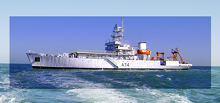
INS Sagardhwani is the 'At-Sea Campus' of NPOL, maintained and run by the Indian Navy for DRDO. The vessel is based at the Southern Naval Command and undertakes survey in coastal and deep waters. The ship has an endurance of 6000 nautical miles at an economical speed of 12 knots for 20 days. The ship provides accommodation for 16 scientists. The vessel has seven laboratories fitted with scientific equipment for measuring oceanographic, meteorological, geological, geophysical, and acoustic parameters. The vessel has facilities to moor oceanographic and acoustic instruments. An Integrated Ocean Survey System (IOSS) installed onboard provides data integration among various laboratories in the ship.
UARF
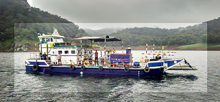
This facility is located at a lake at Kulamavu, in the high-ranges of the Western Ghats. It has been established as a national test facility for underwater acoustic research, so that calibration and full-scale testing of underwater acoustic transducers, arrays and other sub-sea equipment can be carried out in controlled environments, before deploying onboard naval platforms. The reservoir is spread over 60 sq km and the depth varies between 25 m and 125 m. There are three vessels for carrying out the sonar testing and evaluation, including a barge, a floating platform and a motor boat.
Acoustic Tank
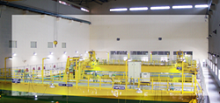
The acoustic tank is 50m long, 20m wide and 18m deep, and can carry out testing and calibration of sonar transducers and acoustic domes by estimating underwater acoustic properties like, reflection, absorption, transmission, insertion loss and acoustic impedance. The tank is equipped with a remote-controlled EOT crane, and 2 moving platforms with turntables, which help to attain a positional accuracy of 1 cm in all 3 directions. Low frequency, high power measurements of bigger transducer arrays can also be carried out.
MATS
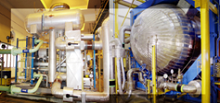
MATS is the only one of its kind in the Asia-Pacific region and one of the very few in the world. This facility is capable of undertaking any static or dynamic measurement, evaluation and calibration of any material or sensors or transducers for underwater use. The test centre has three pressure chambers of different sizes and shapes to cater for underwater measurements on different sensors or materials or equipment under different conditions of temperature and pressure. It also caters to measurements at different operating frequencies
Structural & Thermal Test Facility
This facility is used for the testing of the electronic enclosures as well as the structures of sonar systems. The instrumentation for analysis and testing of electronic enclosures includes the flow meters, pressure gauges, temperature measurements data loggers, humidity meters, sound meters etc. It also houses a blower and associated instrumentation to simulate and study the behaviour of the enclosures in the chilled air ambient in ships or submarines. The facility also houses a crimping machine for clamping of towed arrays and an experimental modal analysis system for dynamic characterization of mechanical components used in marine environments. The modal test facility includes LMS test lab system and a series of impact hammers and accelerometers.
NDT Centre
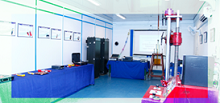
The centre carries out testing and characterisation of sonar components for detection, localisation and quantification of hidden defects such as micro-crack, voids, porosity, delamination, non-bonding, corrosion etc. The tests are done using infrared thermography and microfocal X- ray radiography. The IR thermography is done using the SC3000 'Lock-in Infrared Pulsed Thermal Imaging System' from FLIR, Sweden,and X-ray radiography using a flat panel digital X-ray radiography system from Xylone, Germany.
MEMS Clean Rooms
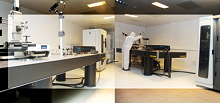
The state-of-the-art clean room facility of Class1000 and Class 100, located in the main campus of NPOL, are used for the manufacture of MEMS & nano-devices, micro-circuits, etc. Assembly and testing of precision electronic assembly are also undertaken. It is possible to achieve and maintain the clean room conditions as per standards through HVAC - Heating, Ventilation and Air-conditioning.
Prototyping Centre

This is a centralised facility for manufacturing of products, prototypes and components for various projects. It has state of art machining facilities to achieve high degree of quality and has well trained workmanship. The facility includes plasma cutting, titanium welding, TIG / MIG welding, rapid prototyping, CNC vertical machining centre, CNC slant bed lathes, 5 axes wire cut EDM, micro drilling, jig boring machine, Coordinate measuring machine and handling equipment
Transducer Moulding Shop
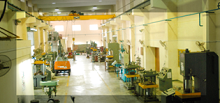
This facility is used for stacking of piezo-ceramics, fibre wrapping and pre-stressing of piezo-ceramic stacks, vacuum assembly of transducers as well as rubber and PU moulding of transducer components. Rubber moulding is done using hydraulic presses, and depending on the type of components, transfer moulding or compression moulding can be adopted. Bonding of vulcanised products is done using the technique of 'Post Vulcanisation Bonding'. Pressure testing chambers are available in the shop for carrying out pressure testing pressure cycling of underwater transducers.
DARPAN
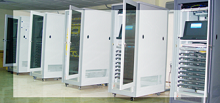
Darpan is a state-of-the-art cluster computing facility established to provide system level simulation of the sonar systems and its environment. It is a Linux Cluster consisting of 40 rack mounted computer nodes each with dual processors that gives about 170 GFlops of performance. Darpan is being used for performance prediction, of alternative sonar designs under various ocean environments, to aid in design optimization of sonar systems before fabricating actual sonar system and before conducting sea trials.
CIEDA

CIEDA is envisaged as an integrated computational facility that aids in the design and engineering of systems. The centre has high-end work stations and other peripheral systems to handle modelling, meshing and analysis, and is equipped with the state-of-the-art software tools. The 3D modelling tools include IDEAS, Pro-E and SOLIDWORKS. Meshing is done using HYPERMESH. Software tools like ANSYS, FLUENT, NISA, ß-SOFT, FloTHERM, CABLECAD and ORCAFLEX are available for carrying out various engineering analysis.
Ocean Data Centre
NPOL established an Ocean Data Centre for augmenting all available and future oceanographic and acoustic data on a single platform. It is an essential infrastructure facility to support design, development, testing, evaluation and deployment of underwater sonar systems/sensors, naval operationsand simulation of tactical warfare scenarios. Moreover, augmentation of all available data onto a single platform is important for online data dissemination and generation of data products to support In-house R&D, System Projects and User operations (Indian Navy).ODC is going to be the single point store house of all type of data for the Ocean Science Group of NPOL which can provides environmental information for the development of the state-of-the-art systems for ASW operations. It may be noted that INS Sagardhwani is the single largest floating platform of DRDO. engaged since 1993, in collection of oceanographic and acoustic data during the field experiments at sea. NPOL also acquires data from various other platforms (sponsored programs) including the naval ships. All these data are being augmented to the oceanographic database of ODC.


